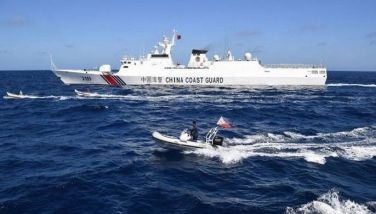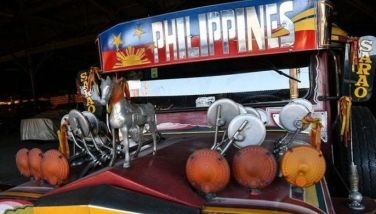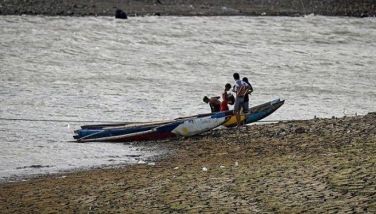Have you been to Aloguinsan? #28StoriesofGiving
ALOGUINSAN, Cebu , Philippines – It’s a family affair: Timoteo Eks does the rowing while his son Angelo does the talking as tourists on a banca traverse the 1.4-kilometer-long, postcard-pretty Bojo River in Aloguinsan, a town tucked away in southwest Cebu.
“In Aloguinsan,” Angelo says in Cebuano, “there are 22 species of mangroves (out of 36 in the entire Philippines) and 61 species of birds – endemic, migratory and resident,” before rattling off what he and his father already know by heart, the local and scientific names of some of the native flora and wildlife, including a couple of striated herons sighted during the relaxing river cruise.
“Years back, we didn’t know these things,” reveals 69-year-old Timoteo, who used to work as a security guard.
The father-and-son tandem is part of a group of “local interpreters” that make up the Bojo Aloguinsan Eco-Tourism Association (BAETAs), a 52-member driving force and custodian of the now award-winning eco-tourism project funded and launched by the municipal government in 2009.
The BAETAs, mostly made up of fishermen, housewives and their children, are qualified guides who regularly undergo seminars and training on tour-guiding, local history, marine resources protection, birding, even personal hygiene as well as livelihood programs.
Most of them reside in the hilly portions just above Barangay Bojo River, which until five years ago held no sentimental value for them because, as they say, they saw it every day and grew up using it for bathing, cooking and washing laundry, as a water source during an El Niño spell, and docking area for their bancas after a long day of fishing.
These days, the Bojo River is the centerpiece of Aloguinsan’s eco-tourism tours and environmental preservation efforts “from ridge to reef” that bring tourists to this small, sleepy fourth-class municipality despite such challenges as rough roads and the absence of regular public transport.
Marketing, for the most part, has been by word of mouth.
Aloguinsan logged 9,000 tourist arrivals over the past year. In April and May, BAETAs remitted about P100,000 in environmental fees, or 10 percent of the P1-million income that goes to the community. During the summer months when business peaks, each member can earn as much as P1,500.
Tour packages range from P300 to P600 per person inclusive of cruise, eco-cultural orientation, meals, boardwalk trek, among others.
Aloguinsan has earned a certification from the European Union Center for Business Initiatives as an export-ready product – highly recommended to European tourists. Last year, it was the recipient of the Inang Kalikasan award given by the Department of Environment and Natural Resources and the Asian Development Bank.
John Grey, father of contemporary eco-tourism, experienced Aloguinsan, trained the guides and praised the project, saying, “This is how eco-tourism should be.”
It has now become a prime example of a “government-enabled, community-driven project.”
“We have transitioned from community-based to community-driven tourism. It’s the community itself that’s bringing it forward,” says eco-tourism expert Boboi Costas, chief consultant of the project since it commenced five years ago.
Mayor Cynthia Moreno tells The STAR, “Like in any LGU system, we are still monitoring it but we’re doing it less and less because it’s already self-sustaining.”
Costas attests that the group has in fact spawned the creation of four other people’s organizations that form a chain of eco-tourism offerings in Aloguinsan, while attracting the attention of municipalities from the Visayas and Mindanao looking to replicate the model in their hometowns.
The project, however, impacts people the most.
When it started, members had no clue what they were getting into. They joined the first meeting and the first activity, a voluntary river clean-up, out of curiosity and because of free snacks being offered. From an initial attendance of hundreds, the number quickly dwindled to 52 as disappointment set in when income was hard to come by.
BAETAs president Rodney Carcuevas recalls, “When we started, we had no model to replicate. We didn’t know where we were going.”
“I’m grateful that we survived because it’s a big help for us in terms of learning and income for the people,” says Jomelyn Manigos, former president of the association.
He adds, “Before, some of us had no electricity, no iron, no cellphone because we couldn’t afford it, now we can enjoy some of these material things and are able to send our children to school.”
More importantly, there’s been a notable shift in their behavior and attitude towards the environment.
“We now understand what eco-tourism is all about,” says Manigos, adding that while they used mangroves for timber in the past, “we’ve learned that mangroves are the nursery and breeding ground of fishes. Decomposed leaves are also food for the fish. More mangroves mean more fish for us. One hectare of healthy mangroves can produce 1.08 tons of fish per year, and fishing is our main source of livelihood. With this alternative livelihood, we are also giving our seas time to breathe.”
Understandably, the members are fiercely protective of their prized possession. They have moved the barangay council to formulate an ordinance prohibiting activities that inflict damage and pollution to Bojo River and nearby areas. They have had made citizen’s arrests of illegal bird poachers and other violators.
On a personal note, exposure to visitors of different cultures and backgrounds has taught the simple townsfolk to become self-confident.
“We used to keep to ourselves because most of us didn’t finish high school,” says Carcuevas. “We would be so nervous facing our guests that our heads were always bowed. Now that we’ve learned to adapt to all kinds of people, we are ready to face anyone.”
Manigos says, “Our biggest joy is when guests appreciate our work and learn something from us even if our interpreters are mere fishermen. We hope people will continue to visit us and see for themselves how eco-tourism has helped uplift lives, as long as there’s cooperation and your heart is in it.”
(Editor’s Note: The Philippine STAR’s #28StoriesOfGiving is a campaign that turns the spotlight on 28 inspiring stories of people and organizations who devote their lives to helping themselves or others. Everyone is encouraged to post or tweet a message of support with the hashtag, #28StoriesOfGiving. For every post, P5.00 will be added to The STAR’s existing ‘give back’ anniversary fund. For comments and suggestions to #28storiesofgiving, email [email protected] follow @philippinestar on Twitter or visit The Philippine STAR’s page on Facebook.)
- Latest
- Trending






























